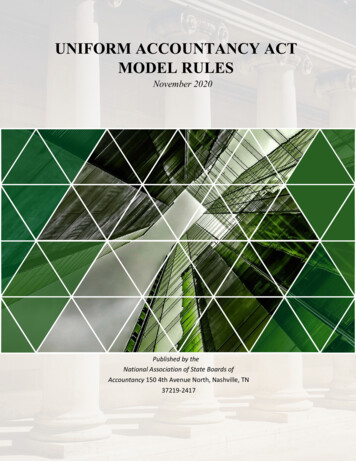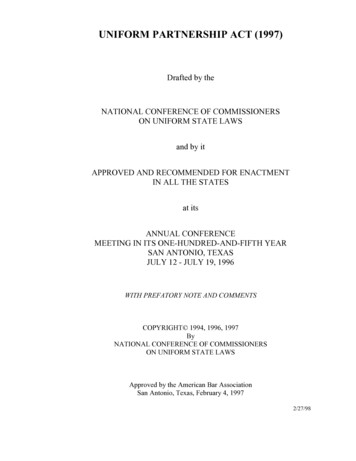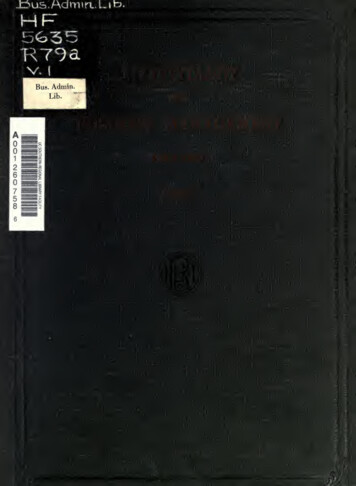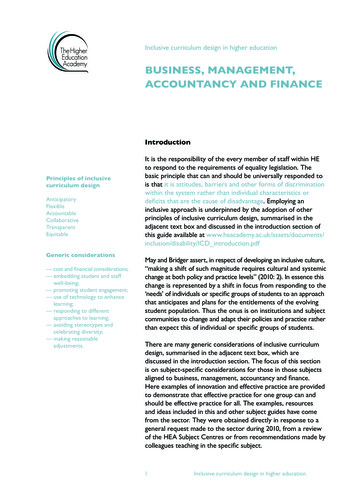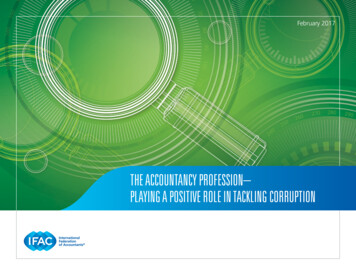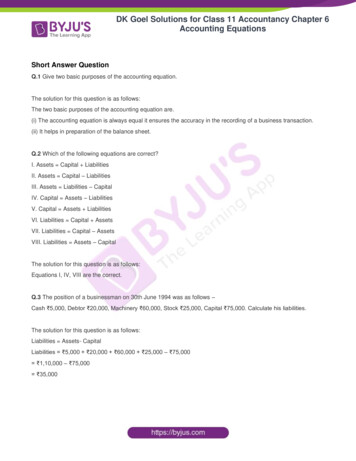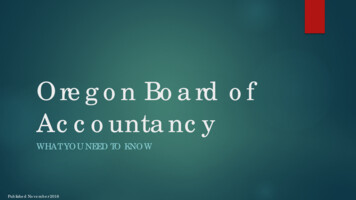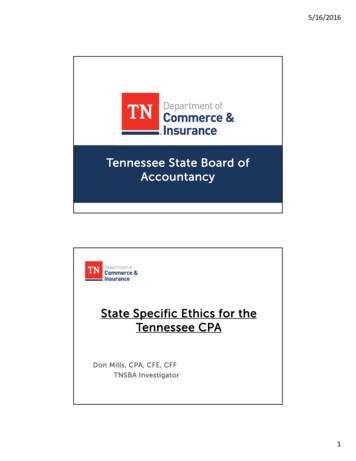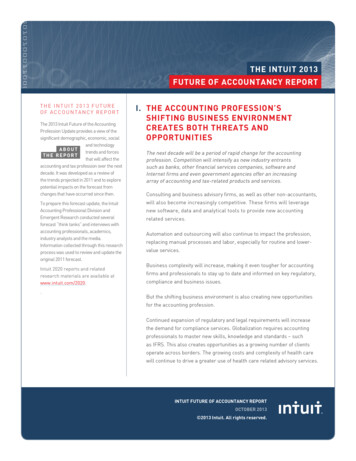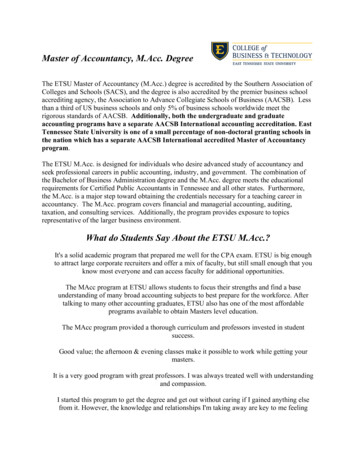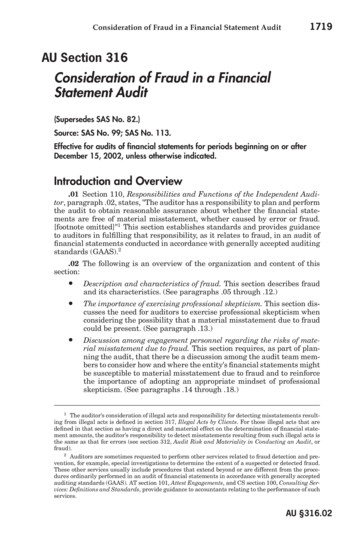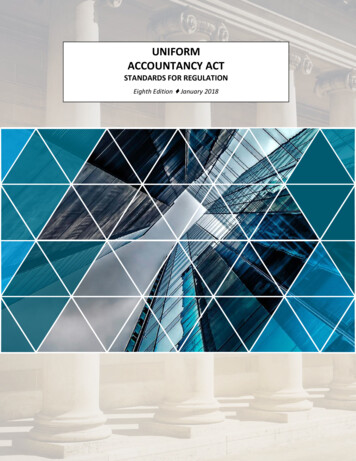
Transcription
UNIFORMACCOUNTANCY ACTSTANDARDS FOR REGULATIONEighth Edition January 2018
Copyright 2018, American Institute of Certified Public Accountants, Inc.220 Leigh Farm Road, Durham, NC 27713National Association of State Boards of Accountancy150 4th Avenue, North, Suite 700, Nashville, TN 37219-2417All rights reserved. For information about the procedure for requesting permission to make copies of anypart of this work, please contact the AICPA at copyright@aicpa.org, or NASBA at NASBAUAA@nasba.org. Otherwise, requests should be written and mailed to the Rights and PermissionsDepartment, AICPA, 220 Leigh Farm Road, Durham, NC, 27707-8110, or to NASBA-UAA, 150 4thAvenue, North, Suite 700, Nashville, TN 37219-2417.1 2 3 4 5 6 7 8 9 0 SR 9 9 8January 2018
December 2017Dear Interested Parties:We are pleased to release the Uniform Accountancy Act (UAA), Eighth Edition, January 2018.This new edition contains important updates to the Act, designed both to ensure protection of thepublic interest and to respond to evolving changes in the practice of accountancy. It is theculmination of numerous meetings of the committees and task forces of the American Institute ofCertified Public Accountants (AICPA) and the National Association of State Boards ofAccountancy (NASBA) as well as the discussions and comments developed by State Boards ofAccountancy, State CPA Societies and other interested parties. We’d like to thank all of thoseindividuals who offered their thoughts, expertise and helpful suggestions along the way.The first of the major changes to the Act is providing for a retired CPA category. This appears inSection 6(d) and acknowledges that CPAs who are at least 55 years of age may place their licensein inactive status and not continue with CPE requirements. For those CPAs at the end of theircareers, this provision offers an exception to ensure that they can continue to offer a limited numberof volunteer, uncompensated services to the public.The second major change can be found in Section 6(g) which allows for the awarding of acertificate to a holder of a substantially equivalent foreign designation without the need for mutualrecognition of US CPAs. The objective is to provide international reciprocity to qualifiedindividuals.Also found in the Eighth Edition of the UAA in Section 3 are definitions of “compilation” and“preparation of financial statements” which serve to clarify other provisions of the Act.In the Model Rules, published separately at www.nasba.org, there are significant changes toArticles 3 and 6 which relate to continuing professional education. These rules are directed to thelicensee and are in accord with the revised “Statement on Standards for Continuing ProfessionalEducation,” found in Appendix A. The “Legislative Policy (Annotated) of the American Instituteof Certified Public Accountants” (Appendix A in earlier editions of the UAA) has been deleted, ashas the NASBA Model Code of Conduct (Rule 10-4 in earlier editions of the Model Rules), sinceneither of those represented joint statements of the AICPA and NASBA.Changes were made to Article 5 to clarify the testing window and other exam policies.To keep the UAA “evergreen,” a continuous process of refreshing the document is necessary.The AICPA/NASBA Uniform Accountancy Act Committee continues to make modificationsthat we believe positively impact the ability of the State Boards of Accountancy to effectivelyJanuary 2018
Interested PartiesDecember 2017Page 2 of 2regulate the evolving profession and to therefore meet the public’s needs. Given the pace of thisevolution, we anticipate releasing interim editions of the UAA more frequently than editions havebeen previously released. Check the NASBA or AICPA websites for the most recent versions.Sincerely,J. Coalter Baker, CPAChair, NASBA UAA CommitteeJanuary 2018Debbie Lambert, CPAChair, AICPA UAA Committee
CONTENTSPageUNIFORM ACCOUNTANCY ACT (UAA)PREFACE . UAA-I-1INTRODUCTORY COMMENTSA Note About Format .UAA-I-3The Fundamental Principles That Should Govern the Regulation ofCertified Public Accountants .UAA-I-3Implementation of the Governing Principles in theUniform Accountancy Act .UAA-I-7Uniform Accountancy ActSection1234567891011121314151617181920Title . 1-1Purpose. 2-1Definitions. 3-1State Board of Accountancy . 4-1Qualifications for a Certificate as a Certified Public Accountant. 5-1Issuance and Renewal of Certificates, and Maintenance of Competency . 6-1Firm Permits to Practice, Attest and Compilation Competency and Peer Review . 7-1Public Accountancy and Firms of Public Accountants. 8-1Appointment of Secretary of State as Agent. 9-1Enforcement – Grounds for Discipline . 10-1Enforcement – Investigations . 11-1Enforcement Procedures – Hearings by the Board . 12-1Reinstatement . 13-1Unlawful Acts . 14-1Injunctions Against Unlawful Acts . 15-1Criminal Penalties . 16-1Single Act Evidence of Practice . 17-1Confidential Communications . 18-1Licensees’ Working Papers; Clients’ Records . 19-1Privity of Contract. 20-1i
212223242526Uniform Statute of Limitations . 21-1Proportionate Liability . 22-1Substantial Equivalency . 23-1Construction; Severability . 24-1Repeal of Prior Law . 25-1Effective Date . 26-1APPENDICESA. AICPA/NASBA Statement on Standards for Continuing Professional Education(CPE) Programs . A-1B. Substantial Equivalency .B-1INDEX . Index-1iiJanuary 2018
UniformAccountancyActEighth EditionAmerican Institute of Certified Public AccountantsNational Association of State Boards of AccountancyJanuary 2018
PrefaceThe modern public accounting profession originated in Great Britain during the latter half of thenineteenth century. In 1896 the New York state legislature passed the first law creating the title“certified public accountant,” thereby setting the pattern for state government regulation of thepublic accounting profession in the United States.As with other professions, the public accounting profession is built upon a statutory foundationproviding for the examination and licensing of members of the profession, and for the regulation oftheir professional conduct. All CPAs are examined, licensed, and regulated under state accountancylaws, and there is such a law in every American jurisdiction.A model bill to regulate the practice of public accountancy was first published in 1916 by theAmerican Institute of Accountants, the predecessor of the American Institute of Certified PublicAccountants (AICPA). In 1984, the AICPA and the National Association of State Boards ofAccountancy (NASBA) published the first joint model bill, later renamed the Uniform AccountancyAct (UAA). Ultimately, a substantial majority of the state accountancy laws followed, in theirprincipal provisions, the example provided by earlier model accountancy bills and the Uniform Act.A joint working group made up of representatives from the AICPA’s State Legislation Committeeand from NASBA’s Uniform Accountancy Act Committee was formed to make changes which wereincorporated into the 1992 Uniform Accountancy Act. Those groups, now acting as a joint UAACommittee, have continued to develop the language for revisions to the UAA, including that foundin this edition.While past joint efforts at promoting high professional standards, protecting the public andincreasing uniformity of regulation have been important, they had not produced the level of resultseither organization felt were satisfactory. Coupled with other significant factors occurring in theglobal marketplace for accounting services, this led both AICPA and NASBA to begin to examinenew ways to respond in this area. The AICPA, through the work of the Special Committee onRegulation and Structure and NASBA through its Reciprocity Committee and Future Licensing,Litigation and Legislation Committee, each began to explore new regulatory concepts andapproaches that would be responsive to the challenges to the current regulatory system.In March 1996, the Joint Committee on Regulation of the Profession (Joint Committee) was formedby AICPA and NASBA to share the concepts and ideas of each organization’s committees and towork to develop consensus on some significant new regulatory changes for the future. The membersof the Joint Committee were leaders of AICPA and NASBA, as well as the state board ExecutiveDirectors group and the Certified Public Accountants’ Society Executives Association (CPA/SEA).After a year of meetings and discussions, the Joint Committee reached agreement on a newregulatory framework that it believed would: enhance interstate reciprocity and practice across statelines by CPAs, meet the future needs of the profession, respond to the marketplace and, mostimportant, protect the public that the profession serves. The Joint Committee’s recommendationswere approved by AICPA and NASBA leadership and were incorporated into the Third Edition ofthe Uniform Accountancy Act, in 1997.UAA-1January 2018
Differing requirements for CPA certification, reciprocity, temporary practice, and other aspects ofstate accountancy legislation in the 55 American licensing jurisdictions (the 50 states, Puerto Rico,the District of Columbia, the U.S. Virgin Islands, Guam, and the Commonwealth of the NorthernMariana Islands) constituted artificial barriers to the interstate practice and mobility of certifiedpublic accountants. The UAA seeks to eliminate such differences and the barriers that they pose toeffective practice of CPAs under modern conditions through the standard of “substantialequivalency” that was added to the Act in 1998. The mobility and enforcement enhancements thathave been added can assure stronger and more efficient state board enforcement in the context ofmodern cross-border and electronic commerce in which state lines are often blurred.Many of the organizations requiring the professional services of certified public accountants transactbusiness on an interstate, and even on an international, basis; as a result, the practice of CPAstypically extends across state lines, and often international boundaries as well. Thus, there iscompelling need for the enactment of uniform state accountancy laws that foster rather than inhibitinterstate professional practice and for laws that provide appropriately for international practice.This UAA is provided as a single comprehensive piece of legislation that could be adopted in placeof existing state laws. Because there is an accountancy law now in effect in every jurisdiction,however, the UAA is also designed to the extent possible with severable provisions, so that particularparts of this Act could, with appropriate amendments, be added to existing laws instead of replacingsuch laws entirely. In the interest of uniformity and to promote mobility through the substantialequivalency standard, the AICPA and NASBA strongly urge states to adopt the entire UAA.Appendix A now contains the new Statement on Standards for Continuing Professional Education(CPE) Programs approved by AICPA and NASBA. Appendix B sets out guidelines as to thesubstantial equivalency standard.The Uniform Accountancy Act is designed to achieve several objectives. As the name of the Actsuggests, the Act advances the goal of uniformity. In addition, the Act’s provisions protect the publicinterest and promote high professional standards.UAA-I-2January 2018
Introductory CommentsA Note About FormatBeginning with the 1992 edition, the Uniform Accountancy Act has been designed as an “evergreen”document.The UAA comprises the complete text of a statute (in boldface type) that could be adopted in placeof any accountancy law now in effect, with explanatory comments (not intended to be enacted aspart of the law) following some provisions printed in regular type. It may happen that a particularlegislature will be interested in considering not a complete new law but only certain provisions, tobe substituted for or added to provisions of the law already in effect.An effort has been made to make the provisions of the UAA readily adaptable for this purpose.However, in the event of piecemeal adoption, it is likely that changes in particular provisions willbe required in order to tailor them to the terminology and structure of the existing legislation. Thecomments attempt to identify important matters that might need to be considered in suchcircumstances, but no effort has been made to identify every point regarding which adaptation mightbe required; that can better be done (and in any event would have to be done) when particularlegislation is actually under consideration.Whether the UAA is considered for adoption wholly or only in part, adjustments may also beappropriate in light of other laws in effect in the particular state in question. Some provisionsincluded in the UAA may be unnecessary, for example, because they are covered by other laws ofgeneral applicability, such as a state administrative procedure act. Other provisions may be at oddswith the way a particular matter is generally dealt with in the state, for example, the authority oflicensing Boards, or their procedures, or their composition. Again, the comments attempt to identifythe principal points requiring consideration in this regard. Provisions, such as the one related to thesize of the Board (Section 4(a)) on which this UAA presents specific choices, are flagged bybrackets.The Fundamental Principles That Should Govern the Regulation of Certified PublicAccountantsThe fundamental principles of the AICPA’s and NASBA’s legislative policies, and of the resultingUniform Act, are few, and can be simply stated.First, statutory regulation of CPAs, as of any other profession or occupation, is justified only byconsiderations of the public interest. The public interest must be a substantial one, since regulationnecessarily involves restrictions on who can perform certain services and the manner in which theyare performed. The conventional formulation is that regulatory legislation must be reasonablydesigned to protect the public health, safety, or welfare; the practice of CPAs has a significant impacton the public welfare.UAA-I-3January 2018
Second, appropriately designed regulation of CPAs serves to protect the public welfare in twoprincipal ways: (a) by providing reasonable assurance of competence on the part of persons andentities that perform those services that require a substantial degree of skill and competence forproper performance and regarding which the consequences of inadequate performance may be ofserious dimension; and (b) by preventing deception of the public regarding the level of competencethat may reasonably be expected of a given practitioner. A central element in the protection of thepublic welfare through the regulation of CPAs is prevention of circumstances in which persons whoare not themselves in a position to judge the competence of a particular practitioner or the reliabilityof particular financial information may be induced to rely on assurances of such competence orreliability (explicit or implied) that are not reasonably supported in fact. Third-party reliancereliance by persons not themselves clients of the certified public accountants whose professionalwork is relied on-is an example of the need for regulating CPAs in the public interest.Third, although an expectation of some minimal level of competence is involved when a person orentity is engaged to perform services for hire, whatever the services may be, the degree to whichsuch an expectation involves a substantial public interest and, in consequence, the degree to whichit justifies legal regulation, varies significantly with both the level of skill required for adequateperformance of the service, and the range and severity of adverse consequences that may derivefrom inadequate performance. Among the many different professional services that CPAs perform,one is, to a far greater degree than any other, affected by considerations of competence, namely, theattest function.Not only does the attest function call for the greatest breadth and most intense development of theprofessional skills employed by CPAs, but it invites the highest degree of reliance by the widestsegment of the public. When attest and compilation services are not competently and properlyperformed, the breadth and severity of the possible adverse consequences are far greater than thoseattendant upon other services performed by CPAs. For these reasons, the keystone of the UniformAct reserves the issuance of reports in standard form on audited, reviewed and compiled financialstatements and other attest information to licensees who have demonstrated qualifications to performattest and compilation services.A professional service similar in nature to the audit function, although differing in the level ofassurance implied, is the conduct of “reviews” of financial statements and the issuance of reportsupon such reviews. Formal standards have been promulgated by the AICPA in a series of Statementson Standards for Accounting and Review Services (SSARS), and reviews conducted in accordancewith such standards may call upon the same level of knowledge as does an audit. Although thedegree of assurance (explicit and implied) in reports upon reviews purporting tocomply with the AICPA’s formal standards is less than that expressed and implied by reportsrepresented to be based upon an audit, the issuance of such reports is restricted to persons wh
certificate to a holder of a substantially equivalent foreign d esignation without the need for mutual . incorporated into the 1992 Uniform Accountancy Act. Those groups, now acting as a joint UAA . Programs approved by AICPA
